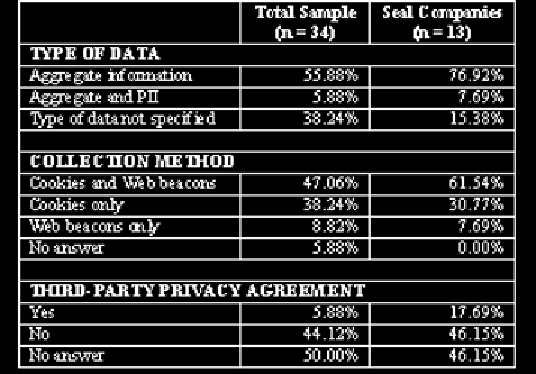Information Technology Reference
In-Depth Information
Table 4. Third-party data collection
way of collecting customer data is storing e-mail
addresses from customer inquiries, which 18%
of the companies admit to doing, while 12% say
explicitly that they do not do so.
The content analysis further examined data
collection by third parties (e.g., advertising net-
works). Overall, 34 (68%) of the companies state
that they allow third parties to collect data on their
Web sites. The results for the 19 seal-companies
echo those for the total sample, with 13 (68.42%)
companies enabling third-party collection. Table
4 gives an overview of what kind of data third
parties are allowed to collect, what methods these
third parties use, and whether these third parties
are required to sign a privacy agreement with the
company enabling this third-party data collec-
tion. The results suggest that the seal companies
have slightly more comprehensive policies, as
the percentages of seal companies providing no
answers or unspecific answers is always lower
than those of the total sample.
As for opting out of third-party data col-
lection, 61.67% of the companies enabling this
form of data collection point to this possibility
but merely refer users to the Web site of the third
party collecting the data. Of the 13 seal companies
enabling third-party data collection, only 53.85%
provide information on opting out of third-party
data collection.
unsolicited marketing
Communications
Sending commercial e-mails such as special of-
fers, product updates, or newsletters to customers
is common practice among the sample companies.
While the majority (82%) offer opt-in or opt-out
facilities for unsolicited e-mails to their customers,
14% send unsolicited e-mails without this option,
and 4% do not disclose any information on this.
Among the seal companies, 78.95% provide opt-in
or opt-out facilities, while the remaining 21.05%
send unsolicited e-mails without opt-in/opt-out. It
often was not clear from the wording of the privacy
policies whether opt-in or opt-out was offered (e.g.,
in phrases like “only when authorized,” “with
your permission,” or “not without your consent.”
In other cases, companies offer opt-in only for
certain types of communications and opt-out for
others. Therefore, opt-in and opt-out were treated
as one category in the analysis.

Search WWH ::

Custom Search